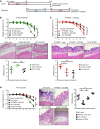Protein tyrosine phosphatase non-receptor type 22 modulates colitis in a microbiota-dependent manner
- PMID: 31107248
- PMCID: PMC6546451
- DOI: 10.1172/JCI123263
Protein tyrosine phosphatase non-receptor type 22 modulates colitis in a microbiota-dependent manner
Abstract
The gut microbiota is crucial for our health, and well-balanced interactions between the host's immune system and the microbiota are essential to prevent chronic intestinal inflammation, as observed in inflammatory bowel diseases (IBD). A variant in protein tyrosine phosphatase non-receptor type 22 (PTPN22) is associated with reduced risk of developing IBD, but promotes the onset of autoimmune disorders. While the role of PTPN22 in modulating molecular pathways involved in IBD pathogenesis is well studied, its impact on shaping the intestinal microbiota has not been addressed in depth. Here, we demonstrate that mice carrying the PTPN22 variant (619W mice) were protected from acute dextran sulfate sodium (DSS) colitis, but suffered from pronounced inflammation upon chronic DSS treatment. The basal microbiota composition was distinct between genotypes, and DSS-induced dysbiosis was milder in 619W mice than in WT littermates. Transfer of microbiota from 619W mice after the first DSS cycle into treatment-naive 619W mice promoted colitis, indicating that changes in microbial composition enhanced chronic colitis in those animals. This indicates that presence of the PTPN22 variant affects intestinal inflammation by modulating the host's response to the intestinal microbiota.
Keywords: Gastroenterology; Inflammatory bowel disease.
Conflict of interest statement
Figures










Similar articles
-
Experimental colitis in IL-10-deficient mice ameliorates in the absence of PTPN22.Clin Exp Immunol. 2019 Sep;197(3):263-275. doi: 10.1111/cei.13339. Epub 2019 Jul 10. Clin Exp Immunol. 2019. PMID: 31194881 Free PMC article.
-
Dietary cranberry suppressed colonic inflammation and alleviated gut microbiota dysbiosis in dextran sodium sulfate-treated mice.Food Funct. 2019 Oct 16;10(10):6331-6341. doi: 10.1039/c9fo01537j. Food Funct. 2019. PMID: 31524900 Free PMC article.
-
TiO2 nanoparticles abrogate the protective effect of the Crohn's disease-associated variation within the PTPN22 gene locus.Gut. 2023 Jun;72(6):1101-1114. doi: 10.1136/gutjnl-2021-325911. Epub 2022 Oct 3. Gut. 2023. PMID: 36191962
-
Interrelatedness between dysbiosis in the gut microbiota due to immunodeficiency and disease penetrance of colitis.Immunology. 2015 Nov;146(3):359-68. doi: 10.1111/imm.12511. Epub 2015 Sep 7. Immunology. 2015. PMID: 26211540 Free PMC article. Review.
-
NLR and Intestinal Dysbiosis-Associated Inflammatory Illness: Drivers or Dampers?Front Immunol. 2020 Aug 11;11:1810. doi: 10.3389/fimmu.2020.01810. eCollection 2020. Front Immunol. 2020. PMID: 32903730 Free PMC article. Review.
Cited by
-
Research advancements and perspectives of inflammatory bowel disease: A comprehensive review.Sci Prog. 2024 Apr-Jun;107(2):368504241253709. doi: 10.1177/00368504241253709. Sci Prog. 2024. PMID: 38778725 Free PMC article. Review.
-
Intestinal Epithelial AMPK Deficiency Causes Delayed Colonic Epithelial Repair in DSS-Induced Colitis.Cells. 2022 Feb 9;11(4):590. doi: 10.3390/cells11040590. Cells. 2022. PMID: 35203241 Free PMC article.
-
Melatonin Alleviates Neuroinflammation and Metabolic Disorder in DSS-Induced Depression Rats.Oxid Med Cell Longev. 2020 Jul 30;2020:1241894. doi: 10.1155/2020/1241894. eCollection 2020. Oxid Med Cell Longev. 2020. PMID: 32802257 Free PMC article.
-
Uncovering the role of the gut microbiota in immune checkpoint blockade therapy: A mini-review.Semin Hematol. 2020 Jan;57(1):13-18. doi: 10.1053/j.seminhematol.2020.05.002. Epub 2020 May 19. Semin Hematol. 2020. PMID: 32690139 Free PMC article. Review.
-
Intestinal Microbiota in Common Chronic Inflammatory Disorders Affecting Children.Front Immunol. 2021 Jun 7;12:642166. doi: 10.3389/fimmu.2021.642166. eCollection 2021. Front Immunol. 2021. PMID: 34163468 Free PMC article. Review.
References
Publication types
MeSH terms
Substances
Grants and funding
LinkOut - more resources
Full Text Sources
Other Literature Sources
Molecular Biology Databases

